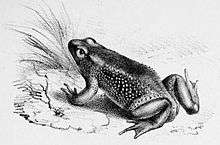Atelopus ignescens
Atelopus ignescens, the Jambato toad or Quito stubfoot toad, is a species of toad in the family Bufonidae. It is endemic to the northern Andes of Ecuador.[1][2][3] This once abundant species was believed to be extinct until its rediscovery in 2016.[1][4] The specific name ignescens means "to catch fire", presumably in reference to the orange ventral color of this species.[5]
| Atelopus ignescens | |
|---|---|
 | |
| Scientific classification | |
| Kingdom: | Animalia |
| Phylum: | Chordata |
| Class: | Amphibia |
| Order: | Anura |
| Family: | Bufonidae |
| Genus: | Atelopus |
| Species: | A. ignescens |
| Binomial name | |
| Atelopus ignescens (Cornalia, 1849) | |
| Synonyms | |
|
Phryniscus ignescens Cornalia, 1849 | |
Taxonomy
A closely related, perhaps undescribed species might exist in Colombia.[2][6] Alexander G. Ruthven believed Atelopus ignescens to be the closest relative of the Guajira stubfoot toad (Atelopus carrikeri).[7] Later studies have indicated that its closest relative is an undescribed species from central Ecuador (Bolívar and Chimborazo Provinces).[3]
Description
Males measure on 34–41 mm (1.3–1.6 in) and females 36–48 mm (1.4–1.9 in) in snout–vent length. The body is robust with long limbs and truncate snout. The dorsal coloration is uniformly black, as is the iris. The ventral side is orange-red; the belly is lighter in color, suffused with yellow.[5]
Conservation
With the last recorded sighting dating to 1988, the species was thought to be extinct until early 2016, when a relict population was discovered in an undisclosed location.[4]
Atelopus ignescens was formerly abundant along streams, rivers and ponds of the páramo surrounding the Ecuadorian capital city of Quito. The species started to decline in the 1980s, probably due to the chytridiomycosis that ravaged other amphibian species around the world, and prior to its rediscovery had been listed as extinct by the IUCN. Other threats include habitat destruction, pollution, climate change, and invasive rainbow trout.[1][4]
References
- IUCN SSC Amphibian Specialist Group (2018). "Atelopus ignescens". IUCN Red List of Threatened Species. 2018: e.T54518A98641865. doi:10.2305/IUCN.UK.2018-1.RLTS.T54518A98641865.en.
- Frost, Darrel R. (2014). "Atelopus ignescens (Cornalia, 1849)". Amphibian Species of the World: an Online Reference. Version 6.0. American Museum of Natural History. Retrieved 7 October 2014.
- Coloma, L. A.; Quiguango-Ubillús, A. (2016). "Atelopus ignescens". Anfibios de Ecuador. Centro Jambatu, Fundación Otonga. Quito, Ecuador. Archived from the original on 2016-06-10. Retrieved 11 May 2016.
- Coloma, L.A. (May 2016). "El Jambato negro del páramo, Atelopus ignescens, resucitó". www.IMciencia.com (in Spanish).
- Coloma, L. A.; Lötters, S.; Salas, A. W. (2000). "Taxonomy of the Atelopus ignescens complex (Anura: Bufonidae): designation of a neotype of Atelopus ignescens and recognition of Atelopus exiguus". Herpetologica. 56 (3): 303–324. JSTOR 3893408.
- Acosta-Galvis, A.R. (2014). "Atelopus ignescens (Cornalia, 1849)". Lista de los Anfibios de Colombia V.03.2014. www.batrachia.com. Retrieved 7 October 2014.
- Ruthven, Alexander G. (May 25, 1916). "Description of a new species of Atelopus from the Santa Marta Mountains, Colombia" (PDF). Occasional Papers of the Museum of Zoology. 1 (28): 1–3. Retrieved 2008-03-26.
